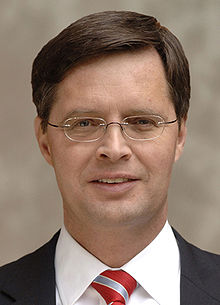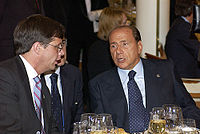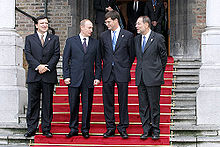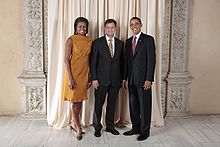- Jan Peter Balkenende
-
Jan Peter Balkenende 
Prime Minister of the Netherlands In office
22 July 2002 – 14 October 2010Monarch Beatrix Deputy See list- Eduard Bomhoff (I)
Roelf de Boer (I)
Johan Remkes (I)
Gerrit Zalm (II, III)
Thom de Graaf (II)
Laurens Jan Brinkhorst (II)
Wouter Bos (IV)
André Rouvoet (IV)
Preceded by Wim Kok Succeeded by Mark Rutte Leader of Christian Democratic Appeal in the House of Representatives In office
1 October 2001 – 11 July 2002Preceded by Jaap de Hoop Scheffer Succeeded by Maxime Verhagen Member of the House of Representatives In office
19 May 1998 – 22 July 2002Personal details Born 7 May 1956
Biezelinge, NetherlandsPolitical party Christian Democratic Appeal Spouse(s) Bianca Hoogendijk (1960) Residence Capelle aan den IJssel, Netherlands Alma mater Free University Occupation Civil servant
Political scientist
Professor[1]Religion Reformed Protestantism[1] Website Ministry of General Affairs Jan Pieter "Jan Peter" Balkenende (Dutch pronunciation: [ˈjɑn ˈpetər ˈbɑlkənˌɛndə] (
 listen)) (born 7 May 1956) is a Dutch politician of the party Christian Democratic Appeal (CDA).
listen)) (born 7 May 1956) is a Dutch politician of the party Christian Democratic Appeal (CDA).He was the Prime Minister of the Netherlands from 22 July 2002 until 14 October 2010, having led four coalition governments, cabinets Balkenende I, II, III and IV, none of which served a full four-year term.
On 9 June 2010, Balkenende resigned his position as party leader of the CDA as well as his seat in the newly elected Netherlands parliament, taking political responsibility for the CDA's disappointing election results in the June 2010 Dutch general election.
He is now a Partner at professional services firm Ernst & Young.[2]
Contents
Personal life
Jan Peter Balkenende, legally Jan Pieter Balkenende, was born in the village of Biezelinge near the town Kapelle in the Netherlands. His father, Jan Pieter Balkenende, was a cereal grains merchant and his mother, Thona Johanna Sandee, was a teacher.
Balkenende went to a Protestant primary school in Kapelle. He attended secondary school at the "Christian Lyceum for Zeeland" in Goes, graduating in 1974.[3] He studied at the Vrije Universiteit in Amsterdam, where he received an M.A. degree in history in 1980, an LL.M. degree in Dutch Law in 1982, and finally a PhD degree in Law in 1992.[3] Balkenende resides with his wife, Bianca Hoogendijk, and his daughter, Amelie, in Capelle aan den IJssel, a suburb of Rotterdam. During his tenure as Prime Minister, he rented an apartment in The Hague, rather than live in the Catshuis, the formal residency of the Prime Minister.
He is a devout[citation needed] member of the Calvinist Protestant Church in the Netherlands.
In 2004, during his second cabinet, Balkenende was diagnosed with necrotizing fasciitis. He was treated through surgical debridement and made a full recovery after several weeks in hospital.
Political career
Early political career
He began his career on the staff of the research institute of the CDA and as a city councilman in Amstelveen. In that period he received his PhD with a thesis on "Administrative regulation and social organisations" (Overheidsregelgeving en maatschappelijke organisaties), a work strongly inspired by the Communitarian ideas of Amitai Etzioni.[4] He later became an extraordinary professor of Christian-Social Thought at the Free University of Amsterdam.
Balkenende first entered the House of Representatives on 19 May 1998 while the CDA was in opposition. He became the CDA's financial spokesman and was also involved with social affairs, justice, and domestic affairs. In this role he advocated a substantial reduction of the national debt and sound public finances.
He was elected Chairman of the CDA parliamentary fraction on 1 October 2001, succeeding Jaap de Hoop Scheffer. On 3 November 2001, he was appointed lijsttrekker for the CDA in the tumultuous May 2002 parliamentary elections. These elections restored the CDA's former position as the largest political party in the Dutch parliament.
Prime Minister
Balkenende has been prime minister of four successive cabinets.
Balkenende I
On 4 July 2002 Queen Beatrix asked Balkenende to form a new government after the general elections following the resignation of Prime Minister Wim Kok. This cabinet is known as Balkenende I. The coalition cabinet included the Pim Fortuyn List (LPF) party, whose leader (Pim Fortuyn) was assassinated just days before the election. It collapsed after just 86 days in office because of internal conflicts within the LPF that destabilised the government.
Balkenende II
After early elections in 2003 Balkenende formed his second government with: Christian Democratic Appeal (CDA), the liberal People's Party for Freedom and Democracy (VVD) and the progressive liberal D66. Once again leader of a centre-right coalition, Balkenende's policies centred around reform of the Dutch public services, reducing crime, a tough immigration policy and historically large cuts in public spending. The measures gave rise to large public anger and bad results in opinion polls for his CDA party. While his party remained the largest Dutch delegation in the European Parliament after the European Elections, beating the general expectation of a huge loss in parliamentary seats, the party suffered strong losses during Dutch municipal elections of 2006, losing their position as the largest party in many municipalities. Despite his unpopularity among Dutch voters (polls in 2006 showed that only 26–33% of the voters had confidence in him as prime minister), his position as leader of the CDA remained stable. In the beginning of 2006, some CDA members tried to replace Balkenende as leader with minister Cees Veerman. Veerman did not accept this and offered his support to Balkenende. Balkenende's popularity recovered since then, surpassing that of his main competitor Wouter Bos in the autumn of 2006. By then, 53% preferred Balkenende as Prime Minister while 40% preferred Bos.[5] This switch in public opinion is sometimes explained by the steady recovery of the Dutch economy during the last year of his administration, combined with declining confidence in Bos as a good alternative for the position of prime-minister.
On 1 July 2004 Balkenende took up the rotating presidency of the European Union.
Balkenende III
On 30 June 2006 D66, the smallest coalition party, withdrew its support of the government over the way immigration minister Rita Verdonk had handled the crisis around the naturalization of Dutch MP Ayaan Hirsi Ali. Balkenende resigned for the second time as Prime Minister, announced early elections and presented his third government a week later. This rump cabinet, formed of a minority coalition of CDA and VVD, stayed in office until the elections of 22 November 2006.
Balkenende IV
Though his old coalition partners VVD and D66 fared badly in the parliamentary elections of 2006, Balkenende managed to defend the dominant position of his CDA. Needing alternative coalition partners to form a new majority government, he formed a social-Christian coalition with the Dutch Labour Party (PVDA) and the orthodox-Protestant ChristianUnion. This Fourth Balkenende cabinet is the current coalition cabinet of the Netherlands, formed by Balkenende, who was appointed formateur by Queen Beatrix on 9 February 2007.[6] His cabinet was announced on 13 February and was scheduled to be in office until 2011, but it fell in the early morning of 20 February 2010 as the result of disagreement between the majority of the parliament and the coalition partners CDA and PvdA over the extension of the Dutch ISAF-mission in Afghanistan.[7] In contrast to the formation of a new caretaker cabinet with full responsibility (Balkenende III after the fall of Balkenende II), Balkenende IV continued as a demissionary cabinet, a caretaker cabinet with limited responsibility.
2010 Election and resignation
Despite serious criticism by former prime ministers from the CDA, Balkenende was the Christian Democratic Appeal Lijsttrekker for the Dutch general election of 2010.[8] Balkenende raised mild controversy during his campaign for the 2010 Dutch elections. While appearing in a television show, Balkenende was asked by a female presenter what parties he would most likely form a coalition with. Balkenende first gave evasive answers, then when asked again by the presenter, responded saying "U kijkt zo lief" (English: You have such a sweet look in your eyes). The comment was regarded as sexist and criticized by several people, including Opzij chief-editor Margriet van der Linden and GroenLinks leader Femke Halsema (who stated that "[the prime minister] deserves a knee to the groin" (in Dutch: "een knietje verdient")).[9] Balkenende apologized for the comment later.[10]
On 9 June 2010, Balkenende resigned his position as leader of the CDA as well as his seat in the newly-elected parliament, taking political responsibility for the CDA's disappointing election results in the 2010 general election.[11]
Honours and awards
Honours
- Order of Orange-Nassau (Netherlands)
- Grand Cross (23 November 2010)
- Member (30 May 1998)
Awards
- Golden Honorary Medal, of the municipality Amstelveen (Netherlands, 30 May 1998)
Honorary degrees
- Honorary doctorate, Hofstra University (New York, USA, 22 May 2011)
- Honorary doctorate in Social Sciences, Yonsei University (Seoul, South Korea, 27 April 2010)
- Honorary doctorate, Keio University (Tokio, Japan, 27 oktober 2009)
- Honorary doctorate, Károli Gáspár University of the Hungarian Reformed Church (Budapest, Hungaria, 10 October 2005)
Other issues
On 4 June 2005, the Belgian Minister of Foreign Affairs Karel De Gucht said in the Flemish newspaper Het Laatste Nieuws (The Latest News) that "Balkenende is a mix of Harry Potter and a petty rigid bourgeois mentality". This comparison caused a small diplomatic controversy, and the Belgian ambassador had to apologise to Ben Bot, the Dutch Minister of Foreign Affairs.[12] Retired Deputy Prime Minister Hans Wiegel commented he preferred Harry Potter to the Manneken Pis.
Balkenende has a close relationship with the Dutch people from Suriname and the Netherlands Antilles. He has visited several Keti Koti celebrations in recent years.
Balkenende has also been accused of breaching International Law by allowing asylum seekers to be placed on barges in Rotterdam Harbour and he has also been accused by Dutch and Dutch-born citizens in Australia and Canada of disregarding their Dutch heritage through a process, illegal in International law, of no longer regarding Dutch emigrants to places such as Australia and New Zealand as being Dutch.
References
- ^ a b CV of Dr JP Balkenende[dead link]
- ^ (Dutch) "Bloomberg". Bloomberg. http://www.bloomberg.com/news/2011-01-31/former-dutch-pm-to-be-partner-in-accountancy-firm.html. Retrieved 2011-02-03.
- ^ a b (Dutch) "Mr. Dr. J.P. Balkenende". Leiden University. http://www.parlement.com. Retrieved 2007-06-07.
- ^ "The Political Center under Pressure: Elections in the Netherlands" (PDF). http://www.progressive-governance.net/uploadedFiles/Articles/Becker%20and%20Cuperus%20article(1).pdf.
- ^ (Dutch)"Balkenende als premier populairder dan Bos". Elsevier. 2006-09-10. http://www.elsevier.nl/nieuws/politiek/nieuwsbericht/asp/artnr/114307/index.html.
- ^ (Dutch) "Balkenende benoemd tot formateur". NOS.nl. 9 February 2007. http://www.nos.nl/nos/artikelen/2007/02/art000001C74C011F6335E9.html.
- ^ Tyler, John (20 February 2010). "Dutch government falls over Afghanistan mission". Radio Netherlands Worldwide. http://www.rnw.nl/english/article/dutch-government-falls-over-afghanistan-mission. Retrieved 20 February 2010.
- ^ (Dutch) Balkenende weer lijsttrekker CDA
- ^ (Dutch)"Balkenende excuseert zich voor 'u kijkt zo lief'". Nederlands Dagblad. 27 May 2010. http://www.nd.nl/artikelen/2010/mei/27/balkenende-excuseert-zich-voor-u-kijkt-zo-lief-.
- ^ (Dutch)"Wat zeg je terug op "U kijkt zo lief"?". NRC. 27 May 2010. http://www.nrcnext.nl/blog/2010/05/27/wat-zeg-je-terug-op-u-kijkt-zo-lief/.
- ^ De Telegraaf. "Balkenende weg als CDA-leider". http://www.telegraaf.nl/binnenland/6906044/__Balkenende_weg_als_CDA-leider__.html?sn=binnenland,buitenland. Retrieved 2010-06-09.
- ^ "Belgian Potter jibe upsets Dutch". BBC News. 6 June 2005. http://news.bbc.co.uk/2/hi/europe/4613087.stm.
External links
- (Dutch) Official Parliamentary Biography
Party political offices Preceded by
Jaap de Hoop SchefferLeader of Christian Democratic Appeal
2001–2010Succeeded by
Maxime Verhagen
ActingLeader of Christian Democratic Appeal in the House of Representatives
2001–2002Succeeded by
Maxime VerhagenPreceded by
Maxime VerhagenLeader of Christian Democratic Appeal in the House of Representatives
2003Leader of Christian Democratic Appeal in the House of Representatives
2006–2007Succeeded by
Pieter van GeelPolitical offices Preceded by
Wim KokPrime Minister of the Netherlands
2002–2010Succeeded by
Mark RutteMinister of General Affairs
2002–2010Prime Ministers of the Netherlands Schimmelpenninck • de Kempenaer • Thorbecke • van Hall • van der Brugghen • Rochussen • van Zuylen van Nijevelt • van Heemstra • Fransen van de Putte • van Zuylen van Nijevelt •van Bosse • de Vries • J. Heemskerk • Kappeyne van de Coppello • van Lynden van Sandenburg • J. Heemskerk • Mackay • van Tienhoven • Roëll • Pierson • Kuyper • de Meester • T. Heemskerk • Cort van der Linden • Ruijs de Beerenbrouck • Colijn • De Geer • Gerbrandy • Schermerhorn • Beel • Drees • de Quay • Marijnen • Cals • Zijlstra • de Jong • Biesheuvel • den Uyl • van Agt • Lubbers • Kok • Balkenende • Rutte
Prime Minister Deputy Prime Minister Ministers Maxime Verhagen (Foreign Affairs & International Development)
Ernst Hirsch Ballin (Justice & Interior and Kingdom Relations
Eimert van Middelkoop (Defence & Housing and Integration)
Jan Kees de Jager (Finance)
Maria van der Hoeven (Economic Affairs)
Piet Hein Donner (Social Affairs and Employment)
Gerda Verburg (Agriculture, Nature and Food Quality)
Camiel Eurlings (Transport, Public Works and Water Management)
Ab Klink (Health, Welfare and Sport)
Tineke Huizinga (Housing, Spatial Planning and the Environment)State Secretaries Ank Bijleveld (Interior and Kingdom Relations)
Marja van Bijsterveldt (Education, Culture and Science)
Jack de Vries (Defence) (resigned) Presidents of the European Council
Presidents of the European CouncilPresident-in-Office (1975–2009) Liam Cosgrave · Aldo Moro · Gaston Thorn · Joop den Uyl · James Callaghan · Leo Tindemans · Anker Jørgensen · Helmut Schmidt · Valéry Giscard d'Estaing · Jack Lynch · Francesco Cossiga · Charles Haughey · Pierre Werner · Dries van Agt · Margaret Thatcher · Wilfried Martens · Anker Jørgensen · Poul Schlüter · Helmut Kohl · Andreas Papandreou · François Mitterrand · Garret FitzGerald · Bettino Craxi · Jacques Santer · Ruud Lubbers · Margaret Thatcher · Wilfried Martens · Poul Schlüter · Helmut Kohl · Andreas Papandreou · Felipe González · François Mitterrand · Charles Haughey · Giulio Andreotti · Jacques Santer · Ruud Lubbers · Poul Schlüter · Aníbal Cavaco Silva · John Major · Poul Nyrup Rasmussen · Jean-Luc Dehaene · Andreas Papandreou · Helmut Kohl · Jacques Chirac · Felipe González · Lamberto Dini · Romano Prodi · John Bruton · Wim Kok · Jean-Claude Juncker · Tony Blair · Viktor Klima · Gerhard Schröder · Paavo Lipponen · António Guterres · Jacques Chirac · Göran Persson · Guy Verhofstadt · José María Aznar López · Anders Fogh Rasmussen · Costas Simitis · Silvio Berlusconi · Bertie Ahern · Jan Peter Balkenende · Jean-Claude Juncker · Tony Blair · Wolfgang Schüssel · Matti Vanhanen · Angela Merkel · José Sócrates · Janez Janša · Nicolas Sarkozy · Mirek Topolánek · Jan Fischer · Fredrik Reinfeldt
Permanent President (since 2009) Categories:- 1956 births
- Living people
- Christian Democratic Appeal politicians
- Dutch academics
- Dutch Calvinist politicians
- Dutch civil servants
- Dutch legal scholars
- Dutch political scientists
- Dutch politicians
- Dutch Reformed Christians from the Netherlands
- Knights Grand Cross of the Order of Orange-Nassau
- Members of the House of Representatives of the Netherlands
- Party leaders of the Christian Democratic Appeal
- People from Capelle aan den IJssel
- People from Kapelle
- Prime Ministers of the Netherlands
- Vrije Universiteit alumni
- Vrije Universiteit faculty
- Eduard Bomhoff (I)
Wikimedia Foundation. 2010.




